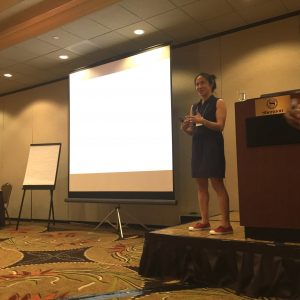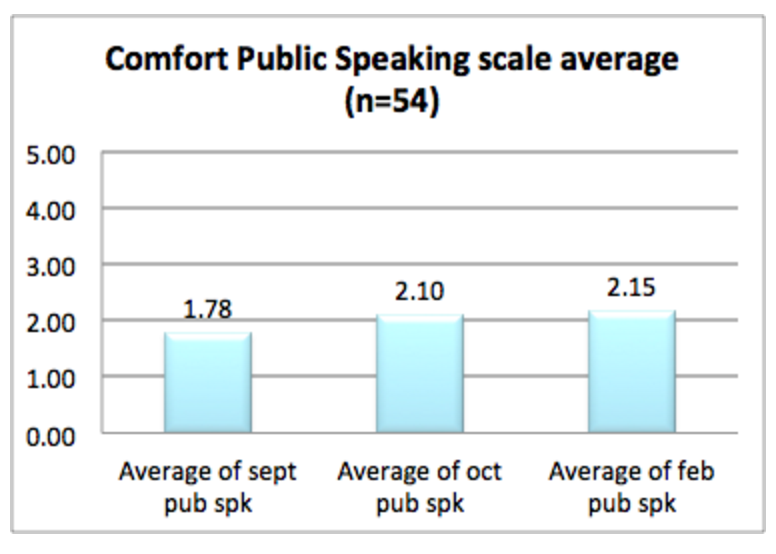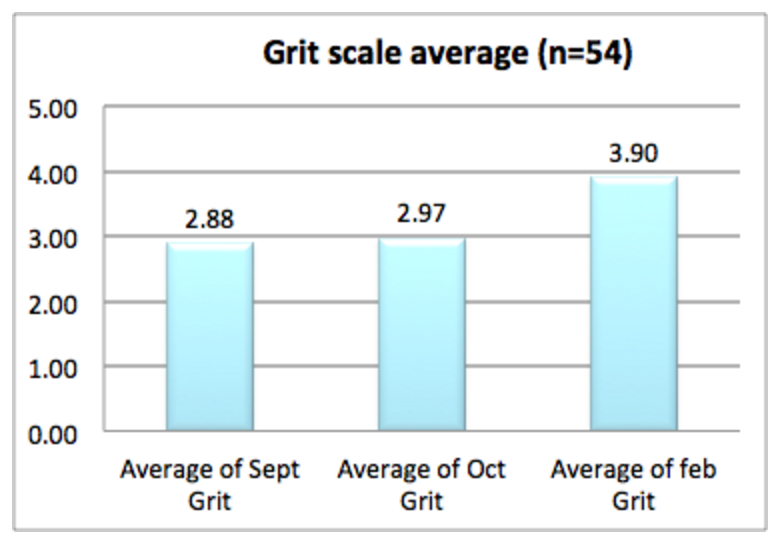In May 2015, I was given what I felt was a once-in-a-lifetime opportunity: conducting action research about the intersection of public speaking and character growth with the support of the bright minds at Character Lab. Character Lab is an edu-research startup founded in part by Angela Duckworth; their website is my first recommendation for people who want to get straight to the best information for understanding and implementing science-based character work in the classroom [1]. Suffice it to say that I was thrilled to be a part of the inaugural Teacher Innovation Grant (TIG) recipient group.
Sadly, I was right about the whole “once-in-a-lifetime” thing. As some of my readers know (several of you submitted what must have been brilliant applications this past December), Character Lab changed direction this past year and ended the Teacher Innovation Grant. This disappointed me greatly, both because I so ardently recommended the application process to my readers and because the TIG represents a novel idea: don't just fund teachers who want to conduct action research, compensate them for the time and effort [2]. It's sad to see a great idea die before it can mature.
Before I share what my project found, please, to those who applied, hear that I am sorry and so are the good people (formerly at Character Lab) who dedicated over a year to making the TIG what it was.
My Original Two Hypotheses
My study was designed to test two hypotheses:
- First Hypothesis: Student anxiety around public speaking could be significantly reduced within the first six weeks of school through
- Daily Think-Pair-Share work during the first three weeks of school, including random, systematic calling during Share time so that every student had participated in Share at least three times total by the end of Week Three.
- Participating in three pop-up debates, one per week, during weeks Four, Five, and Six.
- Second Hypothesis: Student grit would increase if I required students to watch and reflect on video of their pop-up debate performances for the rest of the first semester.
(If you're down on grit, read this before you throw out a baby, please.)

A side note on marshmallows, the time I met Angela Duckworth, and experimental design
When I first heard word that I had received a TIG, I was most excited about the two-day “Research Kickoff” mini-conference in Philadelphia that July, and I was excited because I knew it was going to include a three-hour “mini-PhD” workshop given by Angela Duckworth herself. (See Figure 1.) I thought, “Oh man, Angela and I will become, like, best friends or something.” (Embarrassing to admit, but I want you to see that I, too, am prone to quasi-moronic star worship.)
Her talk was fascinating, but the thing that's pertinent to our discussion today was the “Marshmallow Problem” that she gave us. Here's the TED talk that she cited after the project:
In case you don't have time to watch, you're given some spaghetti and tape and a marshmallow and told to construct a structure that can hold the marshmallow as high as possible. You're also given a limited amount of time, and so the way it typically plays out is that you and your team get straight to taping spaghetti together and don't get to testing the structure with the actual marshmallow until you have barely any time left. Once you test things with the marshmallow, you discover that your structure is way too weak to support the marshmallow, and you end up not doing too well.
And the whole point for us was this: as researchers, when we're designing experiments we have to think ahead to what our “marshmallows” might be. It's not so different from lesson planning for teachers. When we start our careers, we make these epic lesson plans with little ability to foresee the marshmallows, and one of the most salient ways to tell that we're gaining expertise is when we begin anticipating the marshmallows and planning around them. The great teachers aren't the ones who become cynical and assume that any bold, audacious lessons are bound to fail miserably, but rather the ones who anticipate marshmallows and plan around them.
How a Marshmallow Killed One of My Hypotheses
So, given my two hypotheses from the earlier section of this post, guess which one got killed by a marshmallow?
(Take a guess!)
It was the second one because TECHNOLOGY. My plan was to film one class's pop-up debate performances, upload them to YouTube (using the link-only setting to protect student privacy), and have students use a Chromebook cart during the following class period to quickly find their debate performance and fill out a short reflection form. The problem was that YouTube was blocked by my school's filter and my requests to have it fixed were stuck in the mire of bureaucracy. It would take a week to get a confusing “fix” where my students could log in to pass through the filter to access my YouTube videos, and then the fix would make the whole process 3x longer than it needed to be, and then the fix for the fix helpdesk email wouldn't get answered, and before I knew it the semester was over and the experiment window done.
I do still think this is a good idea — not because it will necessarily improve grit in kids (I don't know if it will), but because I'm positive it will improve their speaking skills more than any feedback from me ever can. The thing is, it adds a significant moving part to pop-up debates and at least 10 additional minutes to the process. I'd like to try this again next year, but I'll need to make headway with technology in advance of school starting.
What did my study find?
So what changed between the intake character surveys that my students completed and the concluding ones? There were two changes that my fearless Character Lab guide Michelle McNamara found to be statistically significant [3]:
First, that initial six week intervention (three weeks of think-pair-share followed by three weekly pop-up debates) did produce a statistically significant decrease in public speaking anxiety. (See Figure 2.) Keeping in mind that these results haven't been replicated (I'll try to do that next year, and you should, too — see below for more details), this data suggest that it may not be that difficult for teachers to put a dent in the fear of public speaking in six weeks' time. Imagine if every freshman social studies or English or science or ________ class in the nation made a significant impact on public speaking anxiety every year. How much more courage could our kids have when they graduate? How much more earned confidence?

Second, students were significantly “grittier” (as measured by Duckworth's grit scale) in February than they were in September and October. (See Figure 3.) This is more of a mystery than a revelation. There are just too many things that could have made that happen:
- My colleagues.
- My students' parents.
- My students' experiences in their first semester of high school, including first semester exams.
- Other parts of my class outside of pop-up debates.
- [Insert about 100 other things.]
My hunch is that it's some of all of the above, but especially #3. The first semester of high school is, for many of my students, their first real encounter with academic pressure. We have great teachers K-12 in my district, but high school is the first time adults are talking to you about credits and GPAs and such, and on top of this you're just dealing with a new level of social and extracurricular pressure. That's the kind of refining fire that can drown kids (if given too little support) and refine them (if given proper support). My hunch is that the grit comes from that (and the stellar work of my students' parents and teachers).

What's your next step?
This post is publishing at the start of summer, so I feel comfortable giving you a homework assignment that takes a bit of thought. Is there something you need to do? I see two things for you to consider:
- Sharing a hypothesis about something you do in the classroom using the comments below.
- Testing my first hypothesis in your class(es) this fall. (If you'd like to do that, here are the instructions for the measurement tool.)
Cheers,
Dave
Footnotes:
- I used to recommend Paul Tough's How Children Succeed, but CharacterLab.org does the job much quicker.
- The TIG came with a $10,000 stipend in addition to all project-related costs.
- I'll really miss Michelle next year because I have no idea how to calculate statistical significance, nor am I highly motivated to figure it out.
[hr] Thank you so much to Michelle McNamara, whose hard work on the TIG at Character Lab will, I pray, keep echoing for a long time to come.
Christyn Holmes says
Hi Dave,
I stumbled on to your blog at the beginning of the school year and have enjoyed your thoughtful and useful posts. I wanted to let you and fellow readers know that action research TIG grants are now available via ASCD and very similar to the requirements of the Character Lab application you have been promoting.
More info can be found here: http://www.ascd.org/programs/teacher-impact-grants.aspx
Christyn
Sherri Bublitz says
Hi Dave,
I teach speech and debate for a living in middle school :)! My philosophy has always been “just do it” and it works for most students, but not all. I am revamping my curriculum to use interactive notebooks this next year (rather than notetaking), and I would love to include your hypothesis as well. Having a tool to measure public speaking anxiety is much more concrete than my much more informal observation assessment (what I currently use).
Thank you for your thoughtful posts – they always contain nuggets I can use!
Sherri
davestuartjr says
Sherri, here’s the tool I’m using next year; please read the instructions and let me know if you have any questions!
Holly Stephens says
I just sent a request to view the tool. I may try it next year. I really hit PVLEGS hard first semester, but it wasn’t as easy to work into my curriculum second semester. Even so, many students (some of whom probably had me all year, not just second semester) told me that the PVLEGS work was extremely valuable.
davestuartjr says
Hi Holly, I messed up and shared the wrong thing with you. Use this document, as it contains the right tool and directions.
Lindsay Ann Learning says
Hi Dave, Character Lab has some wonderful resources; thank you for the link in the article! I’m trying to get my thoughts together for some action research tracking student grit as related to student drafting/revision. Would I be able to view the tool you’re using?
davestuartjr says
Hi Lindsay,
Here is the tool I’m using this coming year, which is much simpler than the tool I used last year (found here). The reason I have simplified the tool is because I won’t have Michelle McNamara to pound through the data like the statistics hero she is.
Annie Vickery says
Hi Dave,
I found your blog this year when looking for AoW resources. I have really enjoyed it since. I teach a middle school Humanities (mixed ELA and social studies) class and find your resources very helpful. I like your idea of reducing fear of public speaking in the first six weeks. Middle school kids live under a horror of embarrassing themselves in front of their peers, which they imagine they are doing even when they’re not. Thanks for sharing your ideas – keep ’em coming!